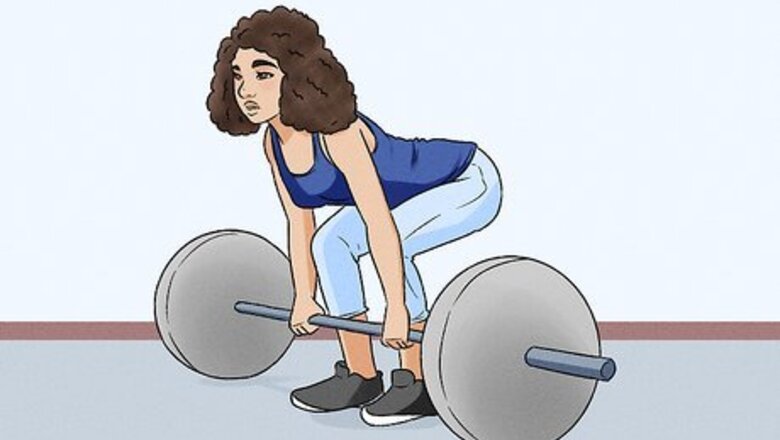
views
X
Research source
Targeting the Right Muscles
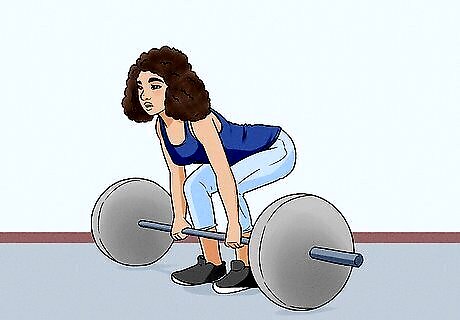
Get the most out of your workout with compound exercises. Exercises that work the main muscle groups (compound exercises) will give you the most significant gains in muscle mass and boost your metabolic rate. For instance, the bench press works your pectorals, your triceps, and your deltoids in a single exercise. An isolated exercise like a tricep kickback will work only your tricep. Compound exercises hit more muscle fibers with each lift, so you get a lot of bang for your buck. Try creating a compound exercise routine with a 4 day upper/lower split or a 3 day full body split to avoid overworking your muscles, which often happens with isolated exercises. Use isolated exercises to tweak your muscle growth an appearance once you have already met your goals. Back squats and Bulgarian split squats are other great compound exercises that you can try.

Build the muscle in your legs and buttocks. To add muscle mass to your lower body, you need to do exercises that target the large muscles in your thighs, calves, and hips. When it comes to building muscles, heavy weights (or high resistance) and low repetitions are the key (while the opposite is true if you are trying to improve your endurance). To build the muscles in your thighs, you need to do exercises that focus on the hamstrings, quadriceps, and hip adductors, such as different variations of lunges, squats, and step ups. Back squats, front squats, and Bulgarian split squats are some excellent thigh-strengthening exercises you can try during your next workout. Deadlifts and glute bridges are great ways to strengthen your glutes. To build the muscles in your calves (gastrocnemius, soleus, and tibialis anterior), do standing or seated calf raises. The muscles in your hips and buttocks (gluteus maximus, abductors, flexors, and deep external rotators) are engaged with some of the same exercises as your legs (such as squats and lunges), but to add more specific exercises to target these muscles, try hip extensions and leg presses. You should do these exercises using resistance that is heavy enough that you can only do 4 to 8 repetitions max. If you can easily do 8 or more reps, you are probably using too low resistance and are building endurance instead of bulking up your muscles. Note for teens: always consult a trainer and a pediatrician before engaging these exercises. Your body is still growing and developing so avoid high intensity and weights.
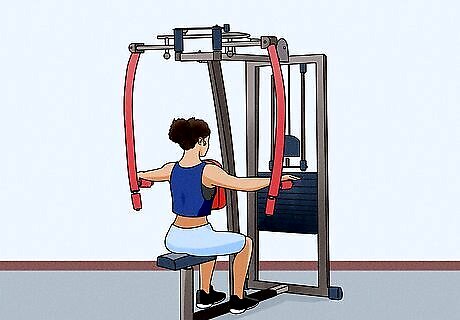
Strengthen and build the muscles in your back. To build the muscles in your back, focus your training on the latissimus dorsi, teres major, trapezius (upper, lower, middle), levator scapulae, rhomboids, infraspinatus, teres minor, and subscapularis muscles. There are a vast variety of exercises you can choose from to build these muscles. Try the different rows (such as bent-over rows, lying rows, and seated rows) or do pull-ups, chin-ups, pulldowns, and shrugs. These exercises can be done using free weights and exercise machines or even just rubber bands or body weight. Strengthening your back muscles can help improve your posture as well.
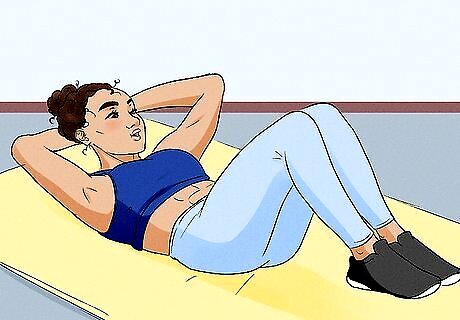
Strengthen your core to get strong abs. To build muscle in your abdomen, focus your training on the rectus abdominis, transverse abdominus, obliques, quadratus lumborum, and erector spinae muscles. When it comes to abdominal muscles, you can use your body weight and do crunches, sit-ups, and leg raises, or you can try something different and use free weights, cables or levers to add some extra resistance and really work those abs.

Build the muscles in your chest. Women might overlook training the muscles in your chest, but you shouldn’t. Working the muscles in your chest helps maintain muscular balance, especially if you are building your back muscles; focusing on just one side of the body, can lead to bad posture. To target the muscles in your chest, focus on exercises that work the pectoralis major, pectoralis minor, and the serratus anterior muscles. Choose two to three different exercises, such as chest dips, bench presses, power lifts, chest presses, and/or flies. EXPERT TIP Laila Ajani Laila Ajani Fitness Trainer Laila Ajani is a Fitness Trainer and founder of Push Personal Fitness, a personal training organization based in the San Francisco Bay Area. With over 10 years as a trainer and exercise specialist, Laila has expertise in competitive athletics (gymnastics, powerlifting, and tennis), personal training, distance running, and Olympic lifting. Laila is certified by the National Strength & Conditioning Association (NSCA), USA Powerlifting (USAPL), and she is a Corrective Exercise Specialist (CES). Laila Ajani Laila Ajani Fitness Trainer Women can perform upper-body workouts without putting on a lot of bulk. Female clients sometimes worry that certain workouts will make their bodies "bulky", or less feminine. However, due to biological factors, it's hard for females to put on the same amount of muscle mass as males. It's unlikely you'll achieve a bulky look unless you're overdoing it at the gym.
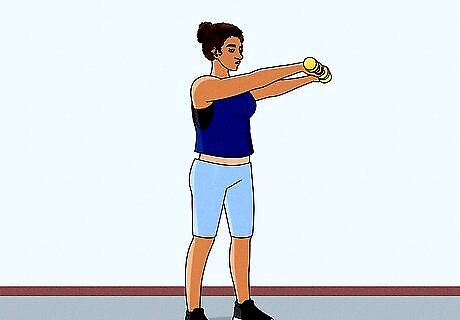
Strengthen your arms and shoulders. Many women want slim and muscular arms and shoulders. To make this happen, target the deltoids (anterior, lateral, posterior) and the supraspinatus in your shoulder and the triceps brachii, biceps brachii, brachialis, brachioradialis and the wrist flexors and extensors in your arms. To build your shoulders, do shoulder or overhead presses, front raises, upright rows, or reverse flies, which can be easily done with cables, barbells or dumbbells for added weight. When working your arms, use dumbbells or exercise machines to do exercises such as triceps dips, kickbacks, triceps extensions, biceps curls and wrist curls and rollers.
Building Muscle with Your Diet
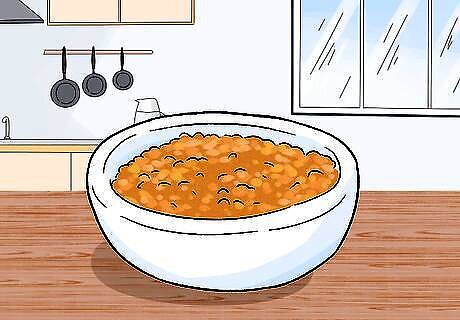
Start your mornings with oatmeal. Building muscle starts with paying attention to what you eat. When it comes to choosing the right carb that is minimally processed and has a low glycemic index (GI) value, there is no better breakfast food than oatmeal. Besides being high in fiber and low in calories, the dietary benefits of oatmeal include ideal micronutrient profile, decreased hunger and increased satiety, and lower subsequent energy intake (second meal effect). Overall, oatmeal is a good way to add healthy carbs to your diet. Avoid pre-packaged oatmeal, which is laden with sugar and artificial flavoring. Cook steel-cut oats and add healthy toppings, like chopped nuts and blueberries.

Eat lean meat. Eating high-quality, high-protein, lean meat is an essential part of gaining muscle. Your digestive system breaks down the protein in meat to amino acids, which are the building blocks of muscle tissue and needed for repair and recovery after exercise. Eat lean cuts of beef (such as eye of round roast, sirloin tip, and top round steak) or ground beef that has less than 7% fat. Low-fat beef is favored by many bodybuilders due to its nutrient content (zinc, iron, and B-vitamins) and high-quality protein. Eat skinless chicken or low-fat turkey, which are excellent sources of lean protein.
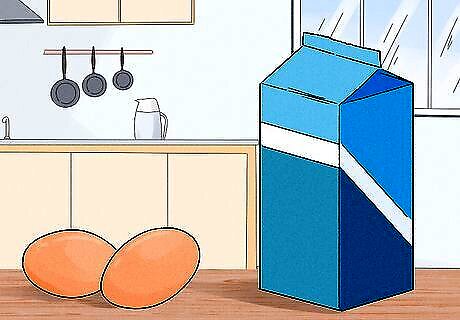
Consume low-fat milk products and eggs. These are also packed with essential nutrients and protein that are needed to build and maintain muscle. Milk products also help strengthen bones during childhood and teenage years. Add low-fat cottage cheese to your diet. Besides being a healthy dessert when combined with fresh berries, it contains protein that is slow to digest and is ideal for muscle maintenance. Note: if you are lactose intolerant, try soy products that are packed with calcium and Vitamin D. Add free-ranged chicken eggs to your diet, which are packed with protein and nutrients (including essential amino acids, choline, and vitamin D). Although eggs are considered high in cholesterol, several recent studies have shown that eggs are not harmful to your health.
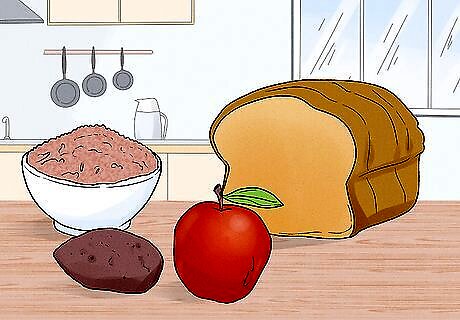
Add nutrient-rich carbs to your meals. Muscles need energy to contract and that energy comes from carbohydrates. If you do not consume nutrient-rich carbs, your workouts will struggle and you will feel tired. Your first meal post-workout should be heavy in carbohydrates. Eat fresh fruits and vegetables that have antioxidants to keep your body healthy. Fruits and vegetables also contain essential vitamins and minerals as well as fiber. Add whole grains (such as brown rice and whole wheat pasta) to your meals, which are packed with good quality carbs and fiber. In addition, brown rice helps to boost hormone levels for growth, which are a critical part for the growth of lean muscle, strength gains, and fat loss. Avoid white bread and pasta made from processed flour.
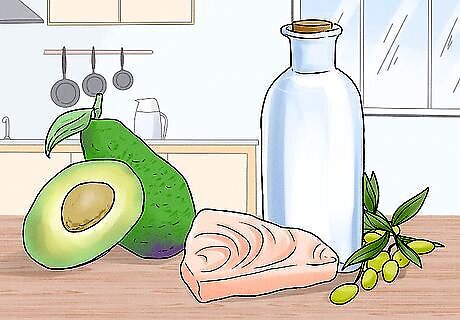
Don’t forget healthy fats. Even though fats have a “bad rap,” your body needs them to provide energy, absorb fat-soluble vitamins and keep your skin and hair healthy. But not all fats are good and you should only eat those foods that contain healthy fatty acids. Consume foods that are high in polyunsaturated and monounsaturated fats, such as nuts, avocados, seeds, and oils (such as olive, safflower, and flaxseed). The above foods are also rich in omega-3 and omega-6 fats -- these are essential fatty acids that your body cannot produce on its own. Eat fish. Besides being packed with omega-3 fatty acids, fish is also a good source of protein. Avoid saturated and trans fats found in butter, regular milk, beef, processed foods and fast foods.
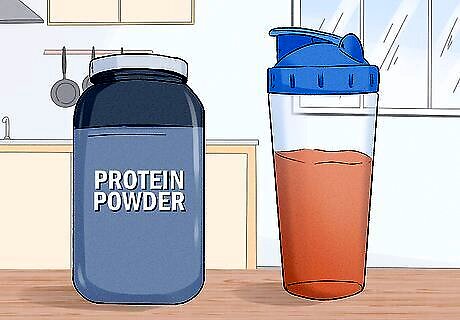
Supplement with whey protein. Whey protein supplementation is popular among athletes wanting to build muscle, mainly because it is an affordable and convenient source of fast protein. Scientific research also shows that whey protein is an excellent source of protein for both adults and children. Use whey protein immediately after workout to replenish your muscles and promote muscle growth. Be sure to get high-quality protein from foods as well and not just from whey protein. Adults can use 20–30 grams (0.71–1.1 oz) of whey protein per day, without exceeding 1.2 grams (0.04 oz) per body weight (kg). Higher doses have been used but should be done with caution and only limited amount of time. Children should get 0.8–1 gram (0.03–0.04 oz) of protein per body weight (kg) per day. Strength training increases your protein consumption and you should consult your doctor on the amount of whey protein supplements (if any) you should consume. Note: too much protein can be harmful and can lead to kidney disease, cancer, and osteoporosis. Always consult your doctor if you are unsure how much protein to eat and before you start using any protein supplements.

Take vitamin supplements (if needed). Healthy and balanced diet is the best way to ensure you are getting enough vitamins and minerals. However, if you are deficient in some vitamins and minerals, you can use supplements to replenish your diet. Always consult your doctor before taking any supplements. Too much fat-soluble vitamins can be toxic to your body.
Building Muscle for Adults

Consult a physical trainer and/or a doctor. Before you start your muscle-building workout season, consult a doctor. Muscle-building exercises are highly demanding to your body, and people with some chronic illnesses (such as cardiac conditions, high blood pressure, or stroke) may not be candidates for this type of workout. If you have high blood pressure (hypertension) you should not do heavy weightlifting without consulting your doctor. If your blood pressure is above 180/110 mm Hg, do not lift weights until you have normalized your blood pressure with medications.

Plan your strength-training workout. Strength training engages the muscles in your body and makes them work against a resistance. When you make your muscles work against a resistance, you are forcing your muscle fibers to respond to the added stress which leads to enhanced muscle size and definition. In order to build muscle, you need to add strength (also called resistance) training to your weekly routine. Typical strength training programs use free weights (dumbbells, barbells), exercise machines, elastic tubing, or even just the body weight (pushups, pull-ups, crunches). Plan a balanced, total body strength training program to build the muscles in your body (see third section).
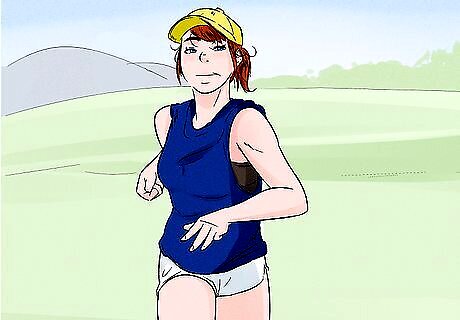
Do not overdo cardio. Muscle building is not fat burning. The best way to add muscle mass is weight training, while the way to get rid of muscles is extended cardio (you've never seen a Marathon runner with big muscles, have you?). However, you should not forget cardio exercises entirely as these strengthen your cardiorespiratory system and have numerous other health benefits, including improving bone strength, reducing blood pressure, reducing risk of chronic illnesses (diabetes, cancer, cardiovascular conditions), and improved mood. Also keep in mind that reducing overall body fat with cardio can cause muscles to "pop," and your body can look leaner and stronger. The key when planning cardio routine during muscle-building season is to do shorter sprints instead of long, aerobic workouts. Focus on 20 minute high-intensity exercises with 30 to 60 second high-intensity sprints followed by 1 minute rests. Do your cardio separately from your weight training workout. Never do your cardio after the weight training workout but reserve it to a separate day. Limit the amount of cardio workouts to 20 minute workouts 3 to 5 times a week.
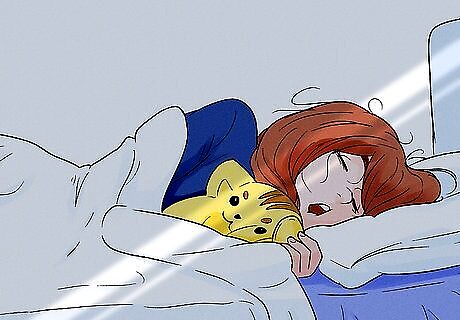
Rest, rest, and rest. Weight training actually causes the muscles to go to a catabolic state (breakdown of muscle proteins). In response, your body has to repair the muscle tissue and during this repair you are actually "building" the muscle mass. Thus, your hard muscle-building workouts need to be balanced with adequate rest. Limit your strength-training workouts to 3 to 4 days a week and do not work the same muscle groups on consecutive days. Ensure you get a good night's sleep every night; it is recommended that adults get at least 7 to 9 hours a sleep each night.

Learn the correct techniques and know the risks. Lifting weights is not only straining to your muscles but your joints and bones as well. If you do not perform each exercise correctly, you may risk an injury. Always consult a trainer and take time to learn to do each exercise correctly before adding heavy weights.
Building Muscle for Children and Teens

Consult your pediatrician. Before your child or adolescent participates in any form of strength training it’s important they consult their doctor. Muscle building routines are slightly different for this age group as their body is still developing and growing. Too much and too hard exercises can cause injury that have lasting effects to a young body. Receiving a medical evaluation beforehand, can help you and your child identify: Training goals. Understanding the proper techniques. Risk factors, such as injuries and the use of steroids or other supplements. Please note that since the overall goal of strength training is to enhance muscle size, a discussion with a pediatrician about steroid use is highly important, especially if your child is involved in a competitive training program.
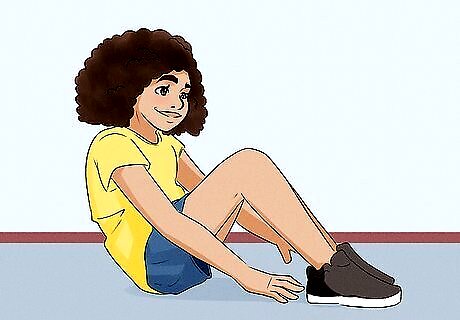
Do strength training. This type of training mainly focuses on weight lifting but exercises using your own body weight (such as sit-ups and push-ups) as well as endurance and agility exercises can also be included to increase muscle strength and size. Weight lifting is the most common strength training technique used in sports and basic workouts. To get started, consult a fitness trainer who can help you or your child learn each exercise and how to perform it correctly. Always warm up to reduce risk of injury by doing at least 5 to 10 minutes of cardio. Stretch lightly before each exercise and after the workout to increase muscle flexibility.
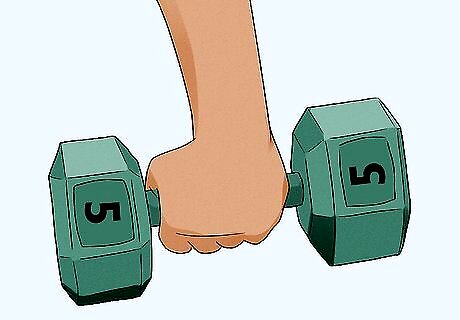
Start with low weights and move to heavier weights as your body gets stronger. Using weights that are too heavy can lead to an injury. Also, it is essential you learn to do each exercise correctly before adding extra weight. Maintain your body mechanics during each move: move slowly, breathe, and understand the complete range of motion. If you do exercises hastily or using the wrong range of motion, you can risk injury. Listen to your body. The intensity of your workout depends on the number of repetitions, the weight, and how long you rest before sets. Don’t over exert yourself. However, you should still be pushing yourself. If you don't challenge your muscles and start moving on to heavier weights, your muscles will not grow or develop.
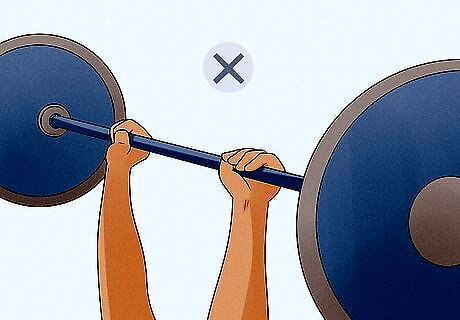
Avoid powerlifting or competitive weightlifting. Teens and children should not engage in competitive weightlifting, powerlifting or bodybuilding. These are highly demanding types of muscle building that are not suitable for children and come with a high risk of injury. Consult with your doctor if you are unsure what type of weightlifting or strength training you or your child should do. The bodies of teens and children are still developing and growing, which greatly increases risk of injury.
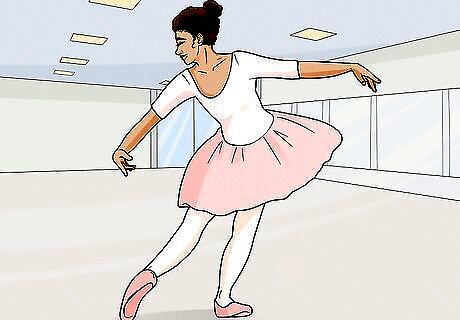
Add aerobic exercises to your weekly routine. Aerobic exercise (or cardio) is a physical activity that raises your heart rate and engages your respiratory system. Regular aerobic exercise has many health benefits, such as maintaining body weight, reducing stress, strengthening your cardiorespiratory system, reducing risk of chronic illnesses (diabetes, cancer), and releasing endorphins to boost your mood. Aerobic exercises that consist of weight-bearing exercises, such as walking, dancing, tennis, and running, also help strengthen your bone mass. Adding aerobic exercises to your weekly routine, helps balance your strength-training workouts and gives a better foundation for later in life.

Know the risks. Any type of physical activity has risks, and this is especially true for strength training. According to the National Electronic Injury Surveillance System, 20,000 to 26,000 strength-training related injuries occurred in people under 21 years old; 40 to 70 percent of those injuries were due to muscle strain, mostly in the lumbar back. Strength-training programs should be well planned and executed to reduce risk of injury. This can be accomplished by: Having a spotter or supervision when weight lifting. Understanding the instructions of the workout so injury doesn’t occur. Understanding the use of the machine. Clearing the workout space so it is hazard free. Including proper warm-up and cool-down exercises.
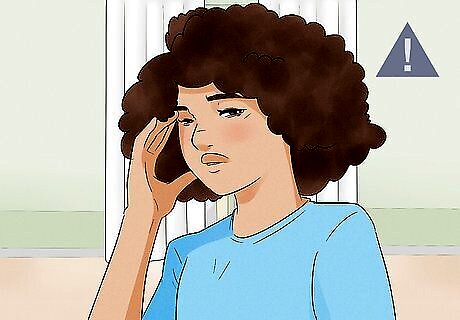
Avoid too much exercise. Working out excessively can harm your body and lead to catabolic state (breakdown of muscle protein). During the teenage years, the body is still developing and therefore, overdoing strength training or burning too many calories can cause your growing body to malfunction. Training should only last one hour or less and you should take a rest day (or two) in between workouts so your muscles can rebuild themselves. Signs to watch to spot overtraining include: high resting heart rate, sleep difficulties, and exhaustion. If you or your child experiences any of these symptoms, cut back on the time or intensity of your workout and consult a doctor. Note to parents: too much exercise can also be a sign of an eating disorder. If you think your child is compulsively working out look for these symptoms: being upset because they missed a workout, exercising even when they’re under the weather, being upset when sitting down because they are not burning calories, and thinking that they will gain weight from going a day without exercise.












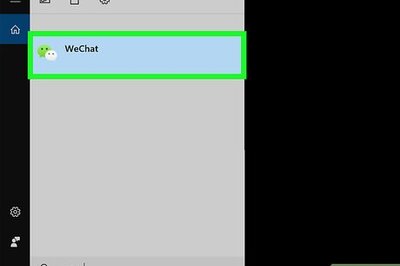





Comments
0 comment